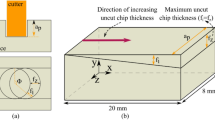Abstract
Optimization of cutting parameters is valuable in terms of providing high precision and efficient machining. Optimization of machining parameters for milling is an important step to minimize the machining time and cutting force, increase productivity and tool life and obtain better surface finish. In this work a mathematical model has been developed based on both the material behavior and the machine dynamics to determine cutting force for milling operations. The system used for optimization is based on powerful artificial intelligence called genetic algorithms (GA). The machining time is considered as the objective function and constraints are tool life, limits of feed rate, depth of cut, cutting speed, surface roughness, cutting force and amplitude of vibrations while maintaining a constant material removal rate. The result of the work shows how a complex optimization problem is handled by a genetic algorithm and converges very quickly. Experimental end milling tests have been performed on mild steel to measure surface roughness, cutting force using milling tool dynamometer and vibration using a FFT (fast Fourier transform) analyzer for the optimized cutting parameters in a Universal milling machine using an HSS cutter. From the estimated surface roughness value of 0.71 μm, the optimal cutting parameters that have given a maximum material removal rate of 6.0×103 mm3/min with less amplitude of vibration at the work piece support 1.66 μm maximum displacement. The good agreement between the GA cutting forces and measured cutting forces clearly demonstrates the accuracy and effectiveness of the model presented and program developed. The obtained results indicate that the optimized parameters are capable of machining the work piece more efficiently with better surface finish.
Similar content being viewed by others
Abbreviations
- A :
-
Cross-sectional area of chip (mm)
- b :
-
Axial depth of cut (mm)
- b r :
-
Radial depth of cut (mm)
- D :
-
Diameter of cutting tool (mm)
- L :
-
Length of work piece (mm)
- F N :
-
Radial force (N)
- F T :
-
Thrust force (N)
- f :
-
Feed rate per tooth (mm/tooth)
- f W :
-
Table feed rate (work piece feed rate), mm/min
- F x , y :
-
Cutting force component in directionx andy (N)
- h :
-
Chip thickness (mm)
- k :
-
Stiffness of the cutter (N/mm)
- m :
-
Average number of teeth in contact with work piece
- N :
-
Rotational speed of milling cutter (rpm)
- R a :
-
Value of surface roughness (μm)
- T :
-
Tool life (min)
- V :
-
Cutting speed (m/min)
- x :
-
Dynamic displacement in feed direction x (mm)
- y :
-
Dynamic displacement in normal direction y (mm)
- Z :
-
Number of teeth on the cutting tool
- φ :
-
Rotational position of cutting edge (degrees)
References
Tolouei-Rad M, Bidhendi M (1997) On the optimization of machining parameters for milling parameters. Int J Mach Tools Manuf 37(1):1–16
Choudhury SK, Rao IVKA (1999) Optimization of cutting parameters for maximizing tool life. Int J Mach Tools Manuf 39(2):343–353
Suresh PV, Venkateshwara Rao P, Deshmukh SG (2002) A genetic algorithmic approach for optimization of surface prediction model. Int J Mach Tools Manuf 42(6):675–680
Sonmez AI, Baykasoglu A, Dereli T, Filiz IH (1999) Dynamic optimization of multipass milling operations via geometric programming. Int J Mach Tools Manuf 39(2):297–320
Kim D, Ramulu M (2004) Drilling process optimization for graphite/ bismaleimide - titanium alloy stacks. Compos Struct 63:101–104
Wang ZG, Wong YS, Rahman M (2004) Optimization of multi-pass milling using genetic algorithm and genetic simulated annealing. Int J Adv Manuf Technol 24(9–10):727–732
Dereli T, Filiz IH, Baykasoglu A (2001) Optimizing cutting parameters in process planning of prismatic parts by using genetic algorithms. Int J Prod Res 9:3303–3328
Juan H, Yu SF, Lee BY (2003) The optimal cutting- parameter selection of production cost in HSM for SKD61 tool steels. Int J Mach Tools Manuf 43:679–686
Tandon V, EI-Mounayri H, Kishway H (2002) NC end milling optimization using evolutionary computation. Int J Mach Tools Manuf 42(5):595–605
Baek DK, Ko TJ, Kim HS (2001) Optimization of feed rate in a face milling operation using a surface roughness model. Int J Mach Tools Manuf 41(3):451–462
Shunmugam MS, Bhaskara Redd SV, Narendran TT (2000) Selection of optimal conditions in multi-pass face-milling using a genetic algorithm. Int J Mach Tools Manuf 40:401–414
Lindberg RA (1995) Process and materials of manufacture. Prentice-Hall of India, p 158
Nagpal GR (1995) Machine tool engineering. Khanna, India, p 118
Toh CK (2004) Static and dynamic cutting force analysis when high speed rough milling hardened steel. Mater Des 25:41–50
Lacerda HB, Lima VT (2004) Evaluation of cutting forces and prediction of chatter vibration in milling. J Brazil Soc Mech Sci Eng 25(1):81
Solis E, Peres CR, Jime J (2004) A new analytical-experimental method for the identification of stability lobes in high-speed milling. Int J Mach Tools Manuf 44:1591–1597
Author information
Authors and Affiliations
Corresponding author
Rights and permissions
About this article
Cite this article
Palanisamy, P., Rajendran, I. & Shanmugasundaram, S. Optimization of machining parameters using genetic algorithm and experimental validation for end-milling operations. Int J Adv Manuf Technol 32, 644–655 (2007). https://doi.org/10.1007/s00170-005-0384-3
Received:
Accepted:
Published:
Issue Date:
DOI: https://doi.org/10.1007/s00170-005-0384-3




